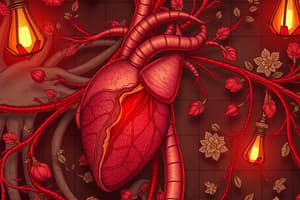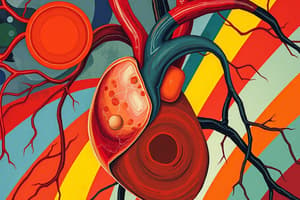Podcast
Questions and Answers
What is the main characteristic of circulatory disorders?
What is the main characteristic of circulatory disorders?
- Decreased blood flow (correct)
- Obstruction of blood flow by clots
- Abnormal protein content in the blood
- Fluid accumulation in interstitial space
Which condition can result from thromboembolic disorders?
Which condition can result from thromboembolic disorders?
- Anaphylactic shock
- Hypertensive heart disease
- Embolism (correct)
- Edema
What distinguishes transudative edema from exudative edema?
What distinguishes transudative edema from exudative edema?
- High white blood cell content
- Excessive protein content
- Low protein content (correct)
- Absence of white blood cells
Which condition leads to anaphylactic shock?
Which condition leads to anaphylactic shock?
What is the cause of spinal or neurogenic shock?
What is the cause of spinal or neurogenic shock?
What is a common consequence of thromboembolic disorders?
What is a common consequence of thromboembolic disorders?
Flashcards are hidden until you start studying
Study Notes
Hemodynamic Disorders
Overview
Hemodynamic disorders refer to a range of conditions that affect the circulatory system, including blood flow, pressure, and fluid volume distribution. They result from changes in the intracellular and extracellular compartments of the body. Hemodynamic disorders can be categorized into circulatory and thromboembolic disorders.
Circulatory Disorders
Circulatory disorders include issues related to blood flow and pressure within the circulatory system. These disorders can result in conditions such as hypertensive heart disease, heart failure, and various forms of heart disease.
Thromboembolic Disorders
Thromboembolic disorders involve the formation of blood clots, which can obstruct blood flow and cause complications such as embolism and infarction.
Edema
An increase in the fluid amount in the interstitial space is called edema. Edema may be localized or systemic. Transudative edema is high in protein content and has an excessive amount of white blood cells, while exudative edema is low in protein content and contains a large number of white blood cells.
Anaphylactic Shock
Anaphylactic shock results from a complication due to a severe allergic reaction or anaphylaxis.
Spinal or Neurogenic Shock
Spinal or neurogenic shock occurs due to injury to the central nervous system, particularly the spinal cord.
Treatment and Symptoms
Symptoms of hemodynamic disorders include low blood pressure, severe dehydration, increased heart rate, and pulse. Treatment for hemodynamic disorders may involve immediate medical treatment and first aid, such as CPR, elevation of legs, and checking breathing and heart rates.
Studying That Suits You
Use AI to generate personalized quizzes and flashcards to suit your learning preferences.



